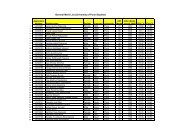Non-parametric estimation of a time varying GARCH model
Non-parametric estimation of a time varying GARCH model
Non-parametric estimation of a time varying GARCH model
You also want an ePaper? Increase the reach of your titles
YUMPU automatically turns print PDFs into web optimized ePapers that Google loves.
intervals <strong>of</strong> homogeneity over the entire period, such that the parameters <strong>of</strong> the process<br />
remain nearly a constant over each interval. The <strong>estimation</strong> is carried out using the<br />
quasi-maximum likelihood (QML) approach. However, the QML procedure is not very<br />
reliable when the sample size is small, since the quasi-likelihood tends to be shallow about<br />
the minimum for small sample sizes, see Shephard (1996), Bose and Mukherjee (2003)<br />
and Fryzlewicz et al. (2008). In addition, the QML estimator does not admit a closed<br />
form solution. The <strong>model</strong> and <strong>estimation</strong> procedure <strong>of</strong> Amado and Terasvirta (2008) also<br />
suffers from similar drawbacks.<br />
We develop a two-step local polynomial <strong>estimation</strong> procedure for the <strong>estimation</strong> <strong>of</strong> the<br />
proposed tv<strong>GARCH</strong> <strong>model</strong>. One can refer to Wand and Jones (1995), Fan and Gijbels<br />
(1996) and Fan and Zhang (1999) among others for the application <strong>of</strong> local polynomial<br />
techniques in various regression <strong>model</strong>s. The proposed two-step <strong>estimation</strong> procedure<br />
requires the <strong>estimation</strong> <strong>of</strong> a tvARCH <strong>model</strong> initially in the first step. In the second step,<br />
we obtain the estimator <strong>of</strong> the tv<strong>GARCH</strong> <strong>model</strong> using the initial estimator. Expressions<br />
for the asymptotic bias and variance <strong>of</strong> the estimators in both the steps are derived and<br />
asymptotic normality is established. It is found that the asymptotic MSE <strong>of</strong> estimators<br />
<strong>of</strong> the parameter functions <strong>of</strong> tv<strong>GARCH</strong> <strong>model</strong> remain invariable for a wide range <strong>of</strong> the<br />
initial step bandwidths, thus making it computation friendly. Moreover, our estimator<br />
achieves the optimal rate <strong>of</strong> convergence under a higher order differentiability assumption<br />
<strong>of</strong> the parameter functions.<br />
Even though this paper deals with tv<strong>GARCH</strong> (1,1) process only, the results presented<br />
here can be extended to a general tv<strong>GARCH</strong> (p,q) with appropriate modifications. In<br />
the empirical analysis <strong>of</strong> financial data, lower order <strong>GARCH</strong> (1,1) <strong>model</strong> has <strong>of</strong>ten been<br />
found appropriate to account for the conditional heteroscedasticity. It usually describes<br />
the dynamics <strong>of</strong> conditional variance <strong>of</strong> many economic <strong>time</strong> series quite well, see for<br />
example Palm (1996). Therefore, in this paper we concentrate on tv<strong>GARCH</strong> (1,1) <strong>model</strong>.<br />
We illustrate the performance <strong>of</strong> the tv<strong>GARCH</strong> <strong>model</strong> using various bilateral ex-<br />
change rate and stock indices data in the past decade. The tv<strong>GARCH</strong> <strong>model</strong> is shown<br />
to outperform several stationary <strong>GARCH</strong> as well as tvARCH <strong>model</strong>s in terms <strong>of</strong> both<br />
in-sample and out <strong>of</strong> sample prediction. The <strong>model</strong> is also found to be performing better<br />
than a long memory <strong>model</strong> in predicting the volatility.<br />
The rest <strong>of</strong> the paper is organized as follows. A tv<strong>GARCH</strong> <strong>model</strong> and its properties<br />
4



